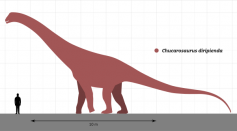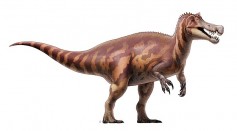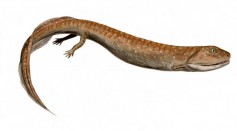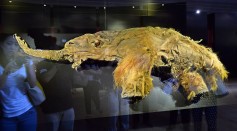Paleontology

Dinosaur Bigger Than T.Rex Weighed 50 Tonnes, Measured Twice London Bus; Bones So Heavy They Tipped Over the Van Carrying Them

Predatory Dinosaur Irritator Had Evolutionary-Shaped Skulls Allowing for Weak but Very Fast Bite, Jaws That Worked Like Pelicans’

How Big Was the T. Rex Population? Study Estimates That There Were 1.7 Billion of Them Lurking Over Earth Prior to Their Extinction

Ancient DNA Reveals Early Humans From China Migrated to the Americas and Japan During the Ice Age

Glowing Golden Fossils From Early Jurassic Site Shed Light on How Exceptional Fossilization Takes Place, New Study Shows

Reconstructed 330-Million-Year-Old Fossils of the 'Tadpole From Hell' Reveal a Shape Similar to a Crocodile

Fossilized Brains, Eyes of 462-Million-Year-Old Creatures Kept in Castle Bank Fossil Deposit in Wales; Could These Be Earth's Early Life Forms?

Top 10 Bizarre Prehistoric Marine Animals That Would Be Classified as Sea Monsters If They Exist Today

Woolly Mammoths Not Always Fluffy and Sport Miniscule Ears, DNA Analysis Reveals

Paleontology Mystery Solved: 300-million-year-old 'Tully Monster' Had No Bones, New Study Says

Dinosaurs Crossed Continents Through Nearly 100-million-year-old Land Bridge in Antarctica, Study Finds

Odd Fur Ball Spotted by Gold Miner Is Actually a 30,000-year-old Mummified Squirrel

Oldest Bats Ever Found? Amazing 52-million-year-old Skeletal Remains Belong to Never-before-seen Species, Paleontologists Say

Mouth Sizes of Extant Sharks Do Not Predict Body Dimensions of Ancient Arthrodire Placoderms like Dunkleosteus, Study Says
Most Popular

How Technology Is Changing the Real Estate Industry?

Study Reveals High Turnover in Scientific Research Careers: What This Means for Future Scientists

How a Plant-Based Diet Can Protect Against Breast Cancer: Insights from Nutrition Research

Why It's So Difficult to Lose Weight: The Biological Explanation Behind Obesity






